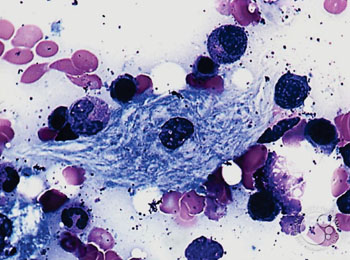Elevated Chitotriosidase Differentially Diagnoses Lysosomal Storage Disorders
By LabMedica International staff writers
Posted on 25 May 2016
Plasma chitotriosidase originates from activated macrophages and is reported to be elevated in many Lysosomal Storage Disorders. Measurement of this enzyme’s activity has been an available tool for monitoring therapy of Gaucher disease.Posted on 25 May 2016
The degree of elevation of chitotriosidase is useful for differential diagnosis of Gaucher disease and Niemann Pick A/B. However the potential utility of this chitotriosidase assay depends on the frequency of deficient chitotriosidase activity in a particular population.

Image: A bone marrow aspirate biopsy of a patient with Gaucher Disease; the cytoplasm has wrinkled tissue paper appearance (Photo courtesy of the American Society of Hematology).
Scientists at Sandor Life Sciences (Hyderabad, India) studied the clinical utility of this assay for Gaucher and Niemann Pick A/B diseases in the backdrop of chitotriosidase deficiency in a local population. The study comprises 173 patients with clinical suspicion of 108 with Gaucher disease or 65 with Niemann Pick A/B and 92 healthy controls.
The scientists found that the plasma samples of controls, Gaucher disease, and Niemann Pick A/B showed chitotriosidase deficiency of 12%, 25% and 27% respectively. The degree of elevation of chitotriosidase in Gaucher disease was 40 to 326 fold (11,325.7 ± 6395.4 nmol/h/mL) and in Niemann Pick A/B patients it was seven to 22 fold (1192.5 ± 463.0 nmol/h/mL). Chitotriosidase deficiency is observed in 22% of the Indian population.
Serum chitotriosidase (CHIT) enzymatic activity is usually determined with the flurometric enzyme activity assay using artificial 4-methylumbelliferyl- substrate. Normal mean and standard deviation CHIT activity in elderly people has been reported as 270 ± 21 nmol/h/mL and in young people as 136 ± 17 nmol/h/mL, but in some individuals no enzyme activity has been observed.
The authors concluded that their findings of distinguishable fold elevation of chitotriosidase in Gaucher disease or Niemann Pick A/B can be a potential surrogate differential diagnostic marker for these groups of diseases, except in the patients in whom this enzyme is deficient. The study was published in the June 1, 2016, issue of the journal Clinica Chimica Acta.
Related Links:
Sandor Life Sciences













